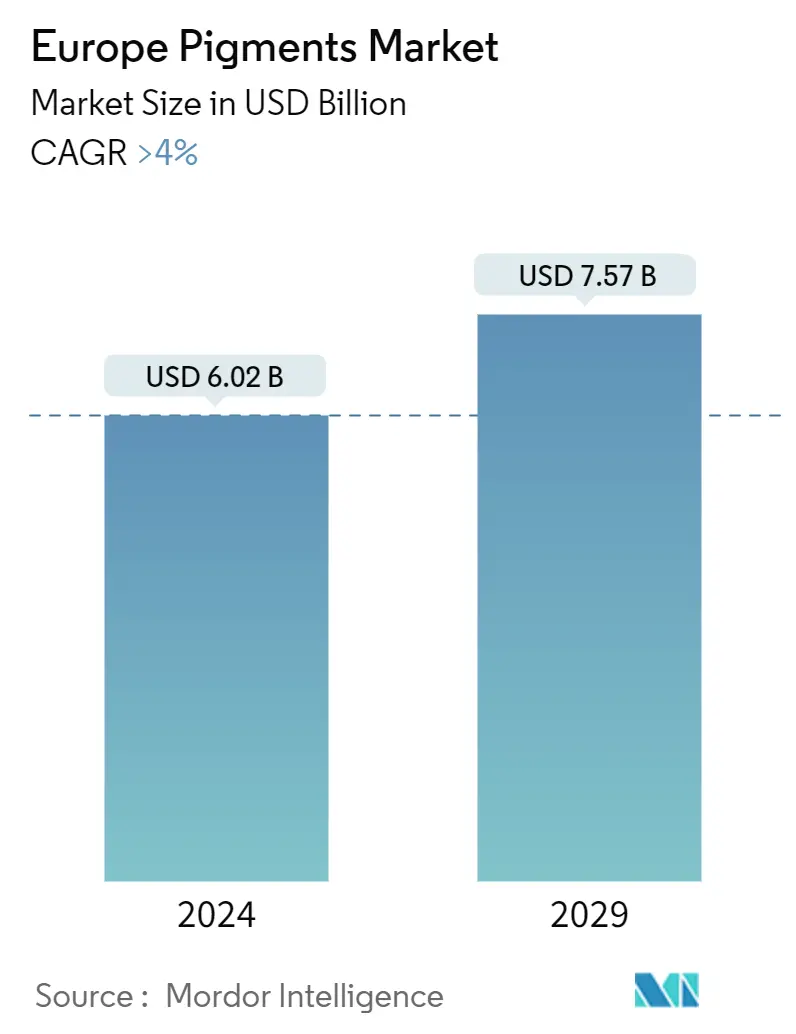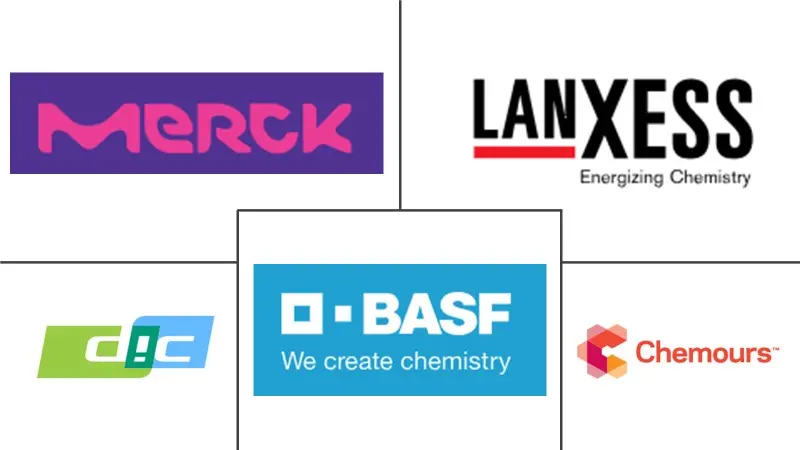Market Size of Europe Pigments Industry

| Study Period | 2019-2029 |
| Base Year For Estimation | 2023 |
| Market Size (2024) | USD 6.02 Billion |
| Market Size (2029) | USD 7.57 Billion |
| CAGR (2024 - 2029) | > 4.00 % |
| Market Concentration | High |
Major Players
*Disclaimer: Major Players sorted in no particular order |
Europe Pigments Market Analysis
The Europe Pigments Market size is estimated at USD 6.02 billion in 2024, and is expected to reach USD 7.57 billion by 2029, growing at a CAGR of greater than 4% during the forecast period (2024-2029).
In Europe, countries like Italy and the United Kingdom were worst hit by the COVID-19 pandemic, which negatively affected the market. Paints, coatings and textiles manufacturing activities were temporarily halted due to the pandemic, which decreased the usage of pigments. However, the market recovered well after the restrictions were lifted. The market recovered significantly, owing to the rise in consumption of pigments in paints and coatings, textiles, and printing ink applications.
Over the short term, growing demand from the paints and coatings industry, increasing demand from the textile industry, and the increasing usage of organic pigments in the printing ink industry are expected to drive the market.
The stringent government regulations on the usage of pigments are hindering market growth.
The shifting focus toward eco-friendly products and rising demand for reliable commercial products, like 3D printing material, are expected to create opportunities for the market during the forecast period.
Germany is expected to dominate the market due to the rising demand for pigments in paints, coatings, and textiles applications. It is also expected to register the highest CAGR during the forecast period.
Europe Pigments Industry Segmentation
Pigments are molecules or substances that absorb specific wavelengths of visible light to produce a particular hue. Pigments can be found in paintings, inks, cosmetics, and other items. Pigments are found in various products and services associated with coloring materials and related technology. Pigments are used in various sectors, including coatings, plastics, printing inks, building, paper, leather, and cosmetics. Organic and inorganic pigments are available, with organic pigments being the most commonly used.
Europe's pigments market is segmented by product type, application, and geography. The market is segmented By product type into inorganic (titanium dioxide, zinc oxide, and other product types (iron oxide, Chromium Oxide, etc.)), organic, specialty pigments, and other product types (metallic pigments, natural pigments, etc.). By application, the market is segmented into paints and coatings, textiles, printing inks, plastics, leather, and other applications (cosmetics, ceramics, electronics, etc.).The report also covers the market size and forecasts for the pigments market in 4 countries in the region.
For each segment, the market sizing and forecasts are provided in terms of value (USD).
| Product Types | |||||
| |||||
| Organic | |||||
| Specialty Pigments | |||||
| Other Product Types (Metallic Pigments, Natural Pigments, etc.) |
| Application | |
| Paints and Coatings | |
| Textiles | |
| Printing Inks | |
| Plastics | |
| Leather | |
| Other Applications (Cosmetics, Ceramics, Electronics, etc.) |
| Geography | |||||||
|
Europe Pigments Market Size Summary
The Europe pigments market is poised for significant growth, driven by increasing demand from the paints and coatings, textile, and printing ink industries. The market experienced a temporary setback due to the COVID-19 pandemic, which disrupted manufacturing activities in key sectors such as paints, coatings, and textiles. However, the market has shown resilience and is expected to continue its upward trajectory, supported by the rising consumption of pigments in these applications. Germany is anticipated to lead the market, fueled by its robust automotive and construction industries, which are major consumers of paints and coatings. The country's strong textile sector further contributes to the demand for pigments, positioning Germany as a dominant player in the European pigments market.
The market landscape is characterized by a consolidation of key players, including BASF SE, DIC Corporation, LANXESS, Merck KGaA, and The Chemours Company. These companies are actively expanding their operations to meet the growing demand for pigments. The focus on eco-friendly products and the increasing use of organic pigments in various applications present new opportunities for market growth. Despite the challenges posed by stringent government regulations, the market is expected to benefit from the rising demand for reliable commercial products, such as 3D printing materials. The ongoing expansion of production facilities, such as Sherwin-Williams' investment in the UK, underscores the industry's commitment to meeting the increasing demand for pigments across Europe.
Europe Pigments Market Size - Table of Contents
-
1. MARKET DYNAMICS
-
1.1 Drivers
-
1.1.1 Growing Demand from the Paints and Coatings Industry
-
1.1.2 Increasing Demand From Textile Industry
-
1.1.3 The Increasing Usage of Organic Pigments in The Printing Ink Industry
-
-
1.2 Restraints
-
1.2.1 The Stringent Government Regulations on the Usage of Pigments
-
1.2.2 Other Restraints
-
-
1.3 Industry Value-Chain Analysis
-
1.4 Porter's Five Forces Analysis
-
1.4.1 Bargaining Power of Suppliers
-
1.4.2 Bargaining Power of Buyers
-
1.4.3 Threat of New Entrants
-
1.4.4 Threat of Substitute Products and Services
-
1.4.5 Degree of Competition
-
-
-
2. MARKET SEGMENTATION (Market Size in Value)
-
2.1 Product Types
-
2.1.1 Inorganic
-
2.1.1.1 Titanium Dioxide
-
2.1.1.2 Zinc Oxide
-
2.1.1.3 Other Product Types (Iron Oxide, Chromium Oxide, etc.)
-
-
2.1.2 Organic
-
2.1.3 Specialty Pigments
-
2.1.4 Other Product Types (Metallic Pigments, Natural Pigments, etc.)
-
-
2.2 Application
-
2.2.1 Paints and Coatings
-
2.2.2 Textiles
-
2.2.3 Printing Inks
-
2.2.4 Plastics
-
2.2.5 Leather
-
2.2.6 Other Applications (Cosmetics, Ceramics, Electronics, etc.)
-
-
2.3 Geography
-
2.3.1 Europe
-
2.3.1.1 Germany
-
2.3.1.2 United Kinfdom
-
2.3.1.3 France
-
2.3.1.4 Italy
-
2.3.1.5 Rest of Europe
-
-
-
Europe Pigments Market Size FAQs
How big is the Europe Pigments Market?
The Europe Pigments Market size is expected to reach USD 6.02 billion in 2024 and grow at a CAGR of greater than 4% to reach USD 7.57 billion by 2029.
What is the current Europe Pigments Market size?
In 2024, the Europe Pigments Market size is expected to reach USD 6.02 billion.

